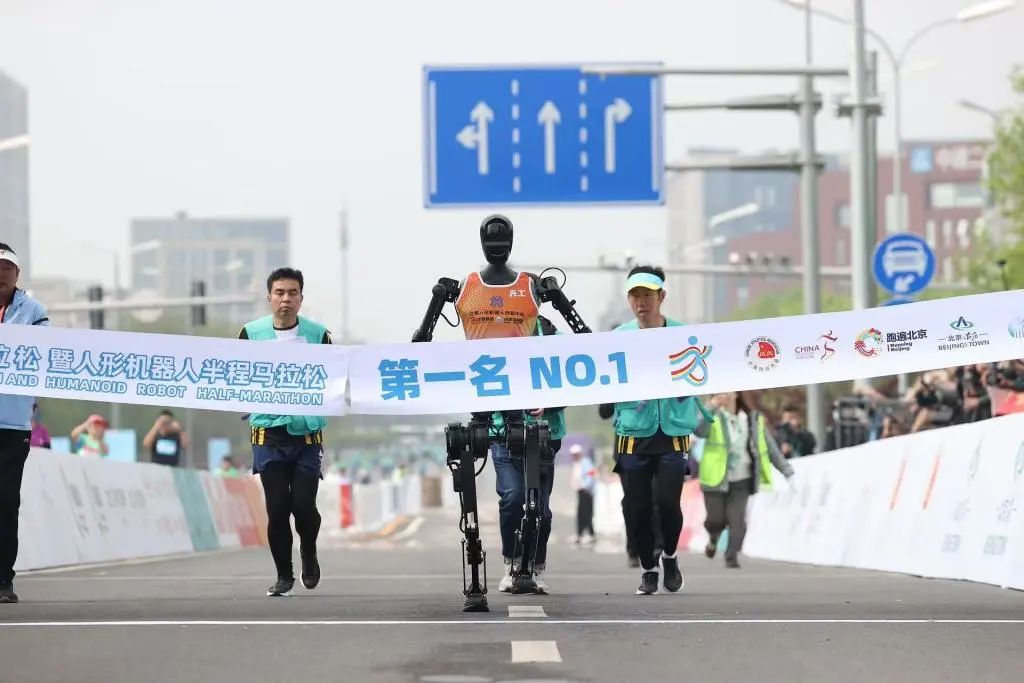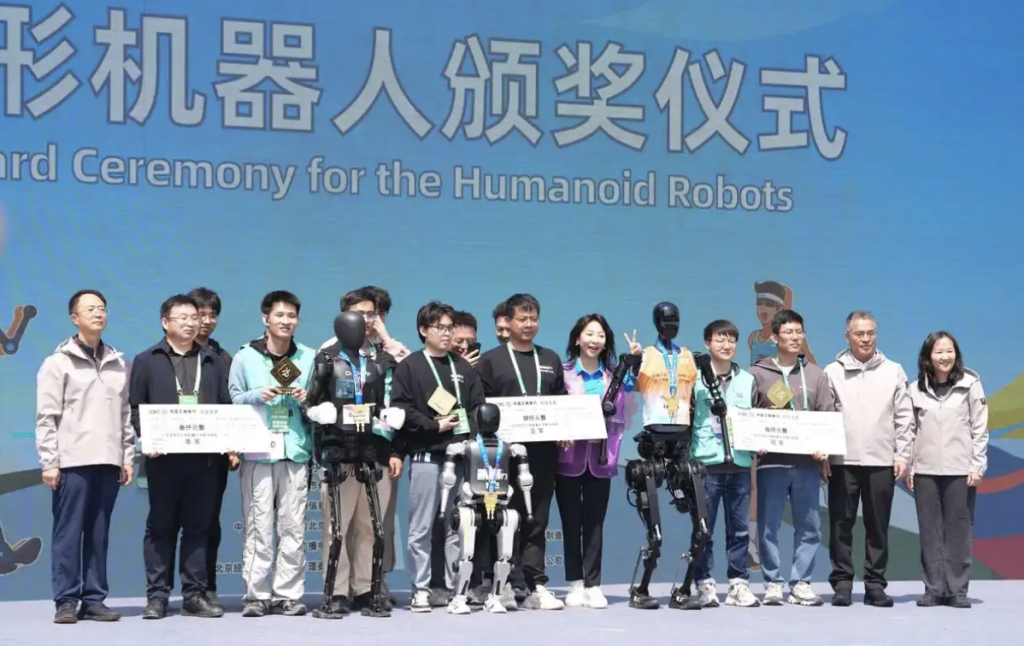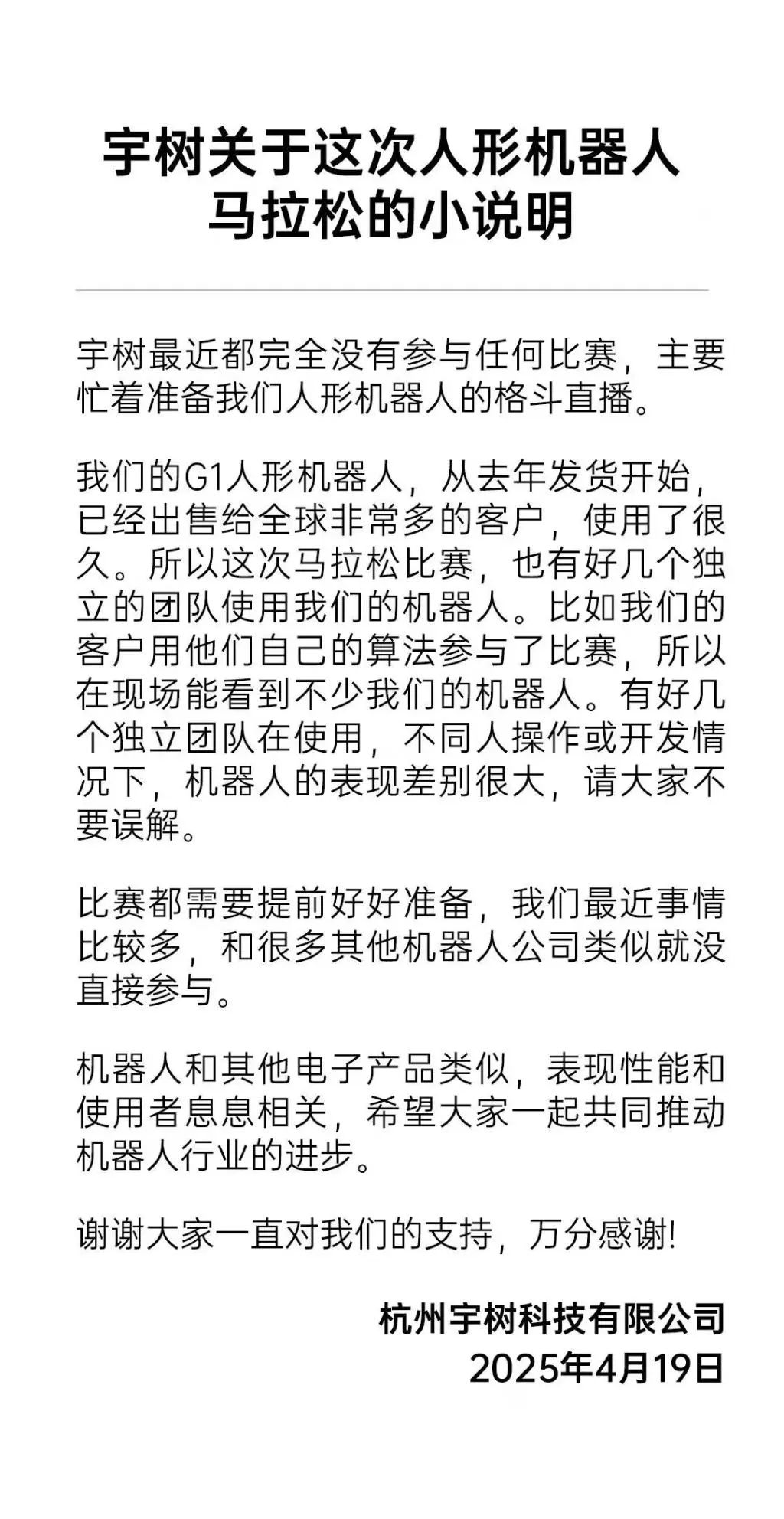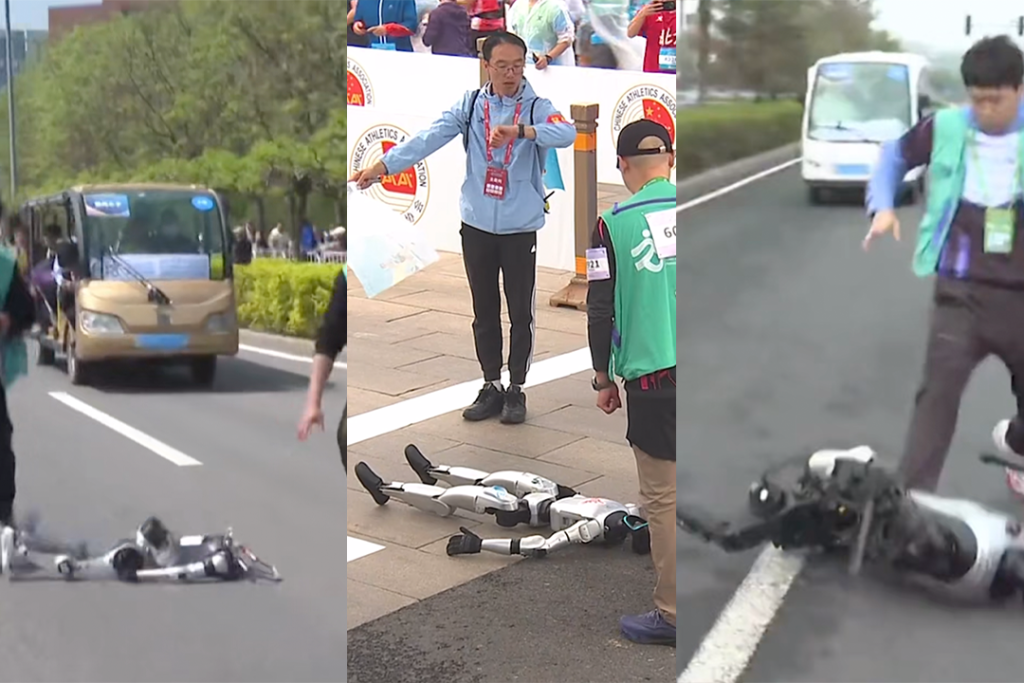Senior Reporter Qin Sheng from The Paper
Videos circulating online show the Yushutech G1 robot falling during the first humanoid robot half marathon. Yushutech stated to The Paper that they have not participated in any competitions recently, as they are primarily focused on preparing for humanoid robot combat live broadcasts.
“Our G1 humanoid robot has been sold to many customers worldwide since its shipment last year and has been in use for a long time. Therefore, several independent teams used our robots in this marathon. For instance, our customers participated in the competition using their own algorithms, which is why many of our robots were seen on-site. The performance of the robots varies greatly depending on the different operators or developers, so please do not misunderstand.”
The temperature in Beijing has risen today, and the half marathon venue in Yizhuang is bustling with activity.
On April 19, the 2025 Beijing Yizhuang Half Marathon and Humanoid Robot Half Marathon officially kicked off. A total of 20 teams participated in this humanoid robot half marathon, using humanoid robot products including Tiangong, Yushutech G1, Leju Kuafu, Songyan Power N2, Walker No. 2, and Acceleration Evolution T1.
The total length of the race is 21.0975 kilometers, with terrain including flat ground and slopes, the maximum gradient reaching 9°. The overall course is smooth, consisting of 6 left turns and 8 right turns, with no return sections and turning angles ≥ 90°, providing GPS coordinate data for the humanoid robot teams. Each team can change batteries, robots, and competitors at the supply station, with penalties for changing robots.
Although many robots stumbled during the race, several “competitors” successfully completed the course, with a total of six teams finishing. The Tiangong team (robot: Tiangong), the Little Rascal team (robot: N2), and the Walker No. 2 team (robot: Walker No. 2) won the first three places, while the fourth place went to the Whirlwind Kid team (robot: Songyan Power N2), the fifth place to the EAI team (robot: Zhuoyide X02), and the sixth place to the Half-Awake Robot team (robot: Spirit).
Additionally, the Tiangong team won the Best Endurance Award, while the Walker No. 2 team, the Intercity Technology team (robot: Yushutech G1), and the Steel Treasure team (robot: Huanhua Robot) received the Best Popularity Award. The Walker No. 2 team, the Intercity Technology team, and the Steel Treasure team won the Best Morphological Innovation Award, while the Walker No. 2 team, the Intercity Technology team, and the Yima Daxiang team (robot: Acceleration Evolution T1) received the Best Gait Award.
 On April 19, Tiangong team player Tiangong Ultra (center) rushed towards the finish line during the competition. Visual China photo
On April 19, Tiangong team player Tiangong Ultra (center) rushed towards the finish line during the competition. Visual China photo
The Tiangong robot comes from the Beijing Embodied Intelligence Robot Innovation Center, co-developed with UBTECH, and was released in 2024. The robot stands about 1.8 meters tall, weighs about 55 kilograms, and can reach a maximum speed of 12 kilometers per hour.
The Tiangong robot is actually an experienced runner, having undergone multiple long-distance running tests previously. Notably, unlike the common remote control methods, the “Tiangong Ultra” used wireless navigation technology for following navigation and long-range path planning, relying on its own control algorithms and multimodal sensors, combined with ultra-wideband wireless technology, to guide the robot in target tracking, calculate its own position, and autonomously adjust its running direction and speed in real-time to reach the target point. During the competition, the “Tiangong Ultra” also utilized battery quick-change technology to achieve long-duration operational endurance.
Xiong Youjun, General Manager of the Beijing Embodied Intelligence Robot Innovation Center, stated after the race that this competition also prepares robots for future entry into factories and service scenarios, envisioning a future society of “human-robot symbiosis” where robots will truly enter our lives. Although this event only showcased a small part of the Tiangong robot’s athletic capabilities, the team is actively developing more innovative technologies and will launch more applications in the future.
He also emphasized: “China’s robotics industry is already in the first tier globally, and our iteration speed, application scenarios, data volume, and talent level are all top-notch worldwide. I am confident in the development of China’s humanoid robotics industry.”

The runner-up, the “Little Guy” Songyan Power N2, was just released last month, standing 1.2 meters tall and weighing about 29 kilograms. It attracted attention upon release due to its dynamic ability to perform consecutive backflips and a starting price of 39,990 yuan.
The third place, Walker No. 2, comes from the Zhongyu Embodied Intelligence Laboratory and Shanghai Zhuoyide Robot Co., Ltd., standing 1.7 meters tall, featuring a tendon-driven bionic lightweight design, weighing only about 28 kilograms, with high endurance and efficiency characteristics, capable of achieving 6 hours of dynamic endurance, and was the only competitor in this event that did not change batteries or robots throughout the race.
The humanoid robots participating in this competition faced various issues, with some failing to start at the starting line, some walking leisurely out of the starting point, some deviating from the direction or falling shortly after starting, and some robots even began to interact with the audience during the race… Two teams also used Yushutech’s G1 robot, but their performance was also unsatisfactory.
In response, Yushutech stated to The Paper that they have not participated in any competitions recently, as they are primarily focused on preparing for humanoid robot combat live broadcasts.
“Our G1 humanoid robot has been sold to many customers worldwide since its shipment last year and has been in use for a long time. Therefore, several independent teams used our robots in this marathon. For instance, our customers participated in the competition using their own algorithms, which is why many of our robots were seen on-site. The performance of the robots varies greatly depending on the different operators or developers, so please do not misunderstand.”

Yushutech stated that competitions require thorough preparation in advance, and due to the company’s recent busy schedule, similar to many other robotics companies, they did not participate directly. “Robots, like other electronic products, have performance that is closely related to the user. We hope everyone can work together to promote the progress of the robotics industry.”

As currently believed in the industry, humanoid robots are still in the early stages, and it will take at least 5-10 years for the technology to mature. Investors and AI industry figures like Zhu Xiaohu and Fu Sheng have repeatedly expressed concerns about the bubble in the humanoid robotics industry, feeling that humanoid robot companies exist merely for show, with unclear commercial paths, and that the most basic work is often neglected.
This humanoid robot half marathon undoubtedly serves as a systematic test of humanoid robots’ comprehensive performance in real environments. “By competing alongside humans, humanoid robots can not only drive technological breakthroughs through extreme scenarios and showcase benchmark application results but also stimulate deep discussions about ‘human-robot symbiosis,’ thereby enhancing public awareness and accelerating the robotics industry’s implementation,” said Liang Jiang, Deputy Director of the Beijing Economic and Technological Development Area Management Committee, before the race.
It is reported that this competition set not only the champion, runner-up, and third place but also completion awards, best endurance awards, best popularity awards, best gait awards, and best morphological innovation awards.
When humanoid robots will truly “run” into human daily life still requires patience.
This issue was edited by Zou Shan.